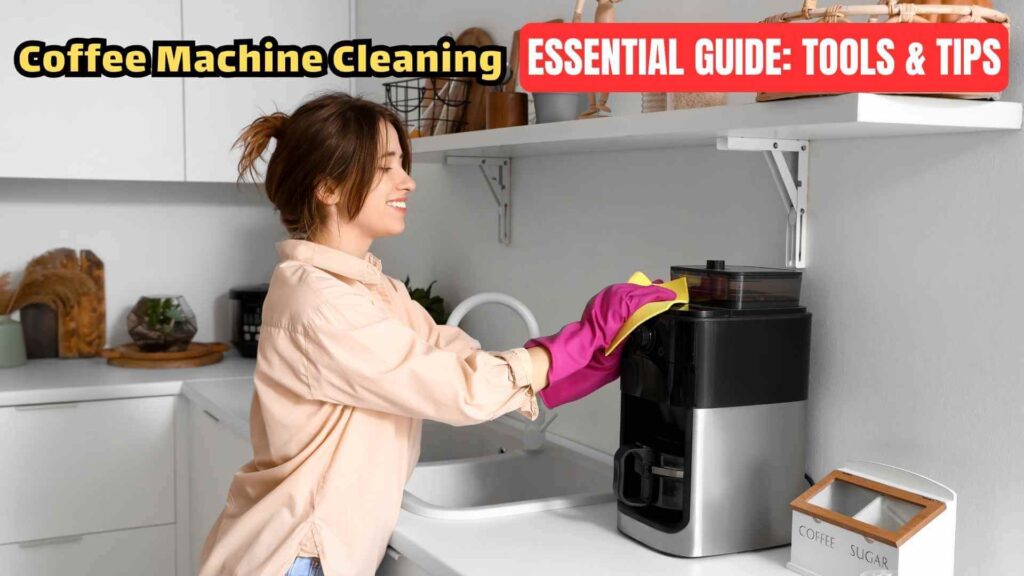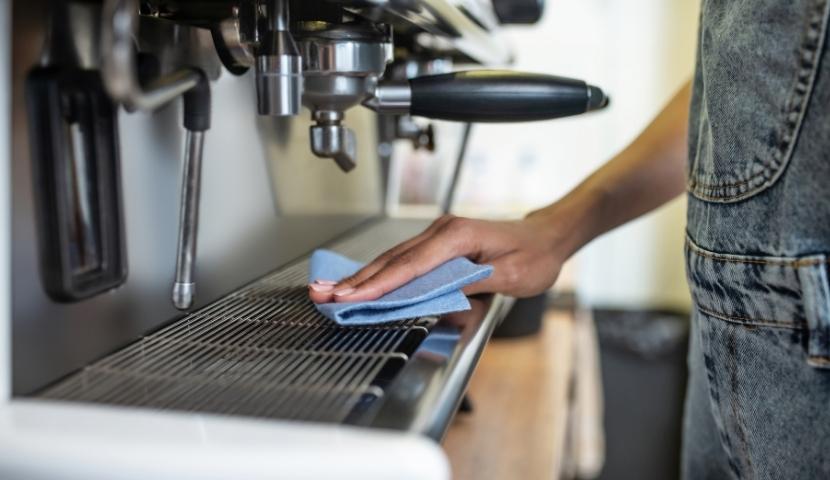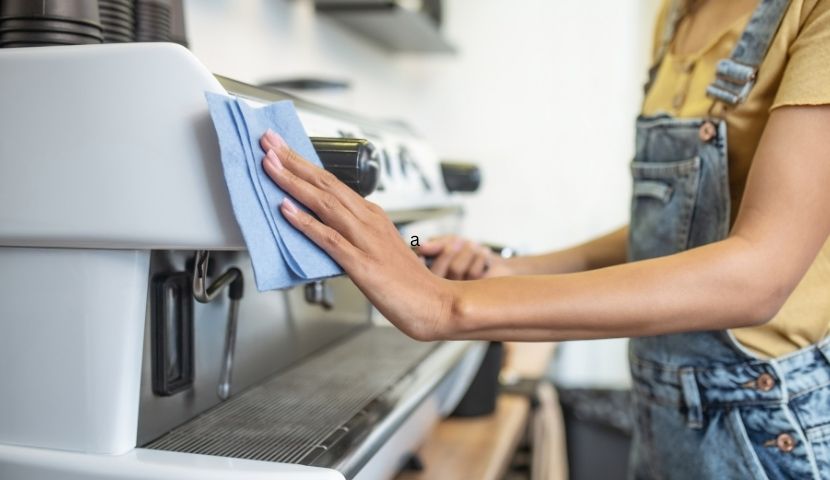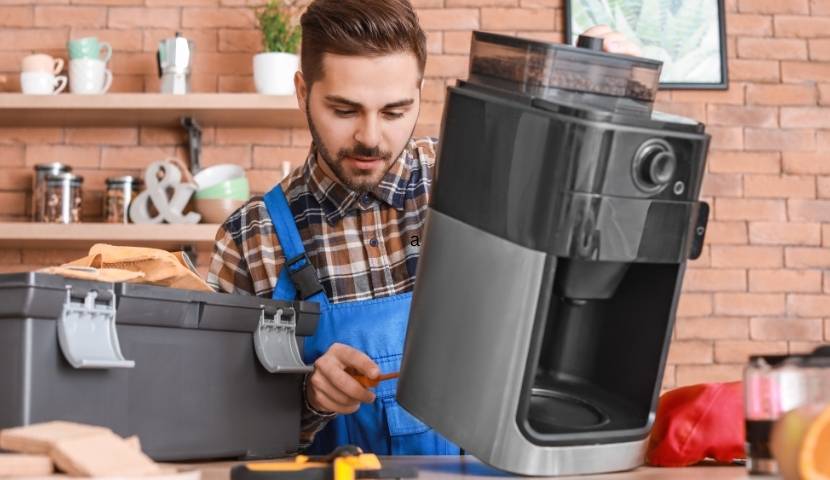Regular cleaning of your coffee machine is essential to ensure each cup you brew is as delightful as the first. Not only does it enhance the taste of your coffee, but it also extends the lifespan of your equipment. In 2025, as we continue to embrace advanced coffee technologies, maintaining our machines has never been more crucial. A clean coffee maker ensures hygienic operation and consistently delivers the rich, flavorful coffee we cherish.
Why Regular Cleaning is Essential for Your Coffee Machine

The Impact of Dirt and Build-Up on Coffee Quality
How Old Coffee Grounds and Mineral Deposits Affect Taste
Over time, coffee oils and residues accumulate within your machine, leading to stale or rancid flavors in your brew. This build-up can cause your coffee to taste bitter or metallic, detracting from the rich flavors of your beans. Regular cleaning prevents these unwanted tastes by removing residual oils and grounds.
The Importance of Keeping Parts Like the Brew Group and Filter Clean
Components such as the brew group and filter are directly involved in the coffee-making process. If not cleaned regularly, they can harbor old coffee particles and oils, leading to inconsistent extraction and flavor. Ensuring these parts are clean helps maintain the quality and consistency of your coffee.
Extending the Lifespan of Your Coffee Machine
Preventing Wear and Tear Caused by Residue Accumulation
Accumulated coffee oils and mineral deposits can cause internal components to wear out faster. Regular cleaning minimizes this build-up, reducing the strain on your machine and preventing premature aging.
How Cleaning Prevents Malfunctions and Costly Repairs
Neglecting maintenance can lead to clogs, leaks, and other mechanical issues, potentially resulting in costly repairs or replacements. Routine cleaning helps identify and address minor issues before they escalate, saving you money in the long run.
Ensuring Hygienic and Safe Operation
Preventing Mold and Bacteria Growth
Moist environments within your coffee machine can become breeding grounds for mold and bacteria if not properly cleaned. Regular maintenance ensures a hygienic brewing process, safeguarding your health.
Importance of Keeping Water Tanks, Drip Trays, and Milk Frothers Clean
Components like water tanks and milk frothers are susceptible to bacterial growth if not cleaned regularly. Ensuring these parts are free from residue and moisture prevents contamination and maintains the quality of your coffee.
How Often Should You Clean Your Coffee Machine?

Daily Cleaning Tasks
Wiping Down the Machine and Emptying the Drip Tray
After each use, wipe down the exterior of your coffee machine to remove any spills or splashes. Emptying the drip tray prevents overflow and maintains a clean workspace.
Cleaning the Coffee Grounds Container and Water Reservoir
Emptying the coffee grounds container and rinsing the water reservoir daily prevents mold growth and ensures each cup is brewed with fresh water.
Weekly Maintenance Checklist
Deep Cleaning the Brew Group, Carafe, and Filter
Remove and clean the brew group, carafe, and filter with warm, soapy water to eliminate oil and residue build-up. This deep cleaning ensures optimal flavor and machine performance.
Running a Water-Only Cycle to Clean Internal Components
Running a water-only cycle helps flush out internal components, removing any lingering coffee oils and ensuring a clean brewing process.
Monthly and Annual Cleaning Considerations
Descaling the Coffee Machine and the Best Descaling Methods
Descaling removes mineral deposits that can affect machine performance and coffee taste. Use a descaling solution recommended by your machine’s manufacturer, and follow the instructions carefully.
Replacing Filters and Checking for Wear on Key Components
Regularly replacing water filters and inspecting components like seals and gaskets prevents leaks and maintains machine efficiency. Refer to your machine’s manual for specific maintenance schedules.
Step-by-Step Guide to Cleaning Your Coffee Machine

Cleaning a Drip Coffee Maker
Detailed Steps: Clean the Carafe, Filter Basket, and Drip Tray
- Carafe: Remove the carafe and wash it with warm, soapy water. For stubborn stains, a mixture of warm water and uncooked rice can help scrub away residue.
- Filter Basket: Take out the filter basket and rinse it thoroughly to eliminate coffee grounds and oils. If it’s dishwasher-safe, placing it on the top rack can provide a deeper clean.
- Drip Tray: Empty and wipe down the drip tray to prevent mold and mildew growth. Regular cleaning ensures your machine operates efficiently.
Best Practices for Descaling Using Vinegar or Descaling Solution
- Prepare the Solution: Fill the water reservoir with a mixture of equal parts white vinegar and water.
- Run a Brewing Cycle: Start a brewing cycle without coffee grounds, allowing the vinegar solution to flow through the system.
- Pause and Soak: Mid-cycle, turn off the machine and let the solution sit for about 30 minutes to break down mineral deposits.
- Complete the Cycle: Resume and finish the brewing cycle.
- Rinse: Run two to three cycles with fresh water to remove any vinegar residue.
This method helps in removing mineral build-up, ensuring your coffee tastes fresh and your machine functions optimally.=
Cleaning an Espresso Machine
Disassembling and Cleaning the Portafilter, Steam Wand, and Group Head
- Portafilter: Remove the portafilter and discard any used coffee grounds. Rinse it under hot water to eliminate residual oils.
- Steam Wand: Purge the steam wand by releasing steam for a few seconds. Then, wipe it with a damp cloth to clear any milk residue.
- Group Head: Use a brush to clean the group head, ensuring no coffee particles are left behind. Perform a backflush with water to clear internal passages.
How to Clean the Grinder, If Applicable
- Empty the Hopper: Remove any remaining coffee beans from the hopper.
- Clean the Burrs: Use a soft brush to sweep away coffee grounds from the burrs. For deeper cleaning, consider using grinder cleaning tablets, which help remove oil build-up.
- Reassemble: Once cleaned, reassemble the grinder and run a small amount of coffee through it to ensure proper operation.
Cleaning a Single-Serve Coffee Maker (e.g., Keurig, Nespresso)
How to Clean the Water Reservoir and Pod Holder
- Water Reservoir: Remove the reservoir and wash it with warm, soapy water. Rinse thoroughly to eliminate any soap residue.
- Pod Holder: Detach the pod holder and rinse it under running water to clear any coffee remnants.
Running Cleaning Cycles to Remove Build-Up from the Machine
- Descaling Solution: Fill the water reservoir with a descaling solution or a mixture of equal parts white vinegar and water.
- Initiate Cleaning Cycle: Place a mug on the drip tray and run a cleaning cycle without inserting a pod.
- Repeat: Continue the cleaning cycle until the reservoir is empty.
- Rinse: Fill the reservoir with fresh water and run additional cycles to ensure all descaling solution is flushed out.
Regular cleaning prevents clogs and maintains the quality of your coffee.
Cleaning a Coffee Grinder
Cleaning Burrs and Blades
- Unplug the Grinder: Ensure the grinder is disconnected from the power source.
- Disassemble: Remove the hopper and any other detachable parts.
- Clean the Burrs/Blades: Use a brush to remove coffee grounds from the burrs or blades. For a deeper clean, consider using grinder cleaning tablets.
- Reassemble: Once cleaned, reassemble the grinder and run a small amount of coffee through it to ensure it’s functioning correctly.
Removing Coffee Oil Build-Up and Keeping It Functioning Properly
Regularly cleaning your grinder prevents oil accumulation, which can affect the taste of your coffee and the grinder’s performance.
Tools and Products You’ll Need

Best Cleaning Tools for Coffee Machines
Recommended Brushes, Microfiber Cloths, and Sponges
- Brushes: Soft-bristled brushes are ideal for cleaning grinders and espresso machine group heads without causing damage.
- Microfiber Cloths: These are excellent for wiping down machine exteriors and removing residue without leaving lint behind.
- Sponges: Non-abrasive sponges are suitable for cleaning carafes and other components without scratching surfaces.
The Importance of Using Non-Abrasive Tools to Avoid Damaging the Machine
Using non-abrasive tools ensures that you clean your coffee machine effectively without causing scratches or other damage to delicate parts.
Cleaning Solutions and Products
Best Descaling Solutions and When to Use Them
Selecting the appropriate descaling solution is crucial for maintaining your coffee machine’s performance and extending its lifespan. Here are some top-rated options:
- Urnex Dezcal Descaling Powder: Renowned for its effectiveness, Urnex Dezcal is a non-toxic powder that efficiently removes mineral buildup. It’s suitable for various coffee machines and is recommended for monthly descaling.
- Citric Acid: A natural alternative, citric acid is both affordable and efficient in descaling. It’s especially effective in removing scale without leaving a strong odor. A five-pound bag costs about 34 cents per ounce, making it a budget-friendly choice.
- PurTru Descaling and Cleaning Solution: This eco-friendly solution uses food-grade citric acid to descale without leaving an aftertaste. It’s gentle on machine components while effectively removing mineral deposits.
DIY Natural Cleaning Options (e.g., Vinegar, Citric Acid)
For those who prefer natural cleaning methods, here are some options:
- White Vinegar: A common household item, white vinegar effectively breaks down mineral deposits. However, it has a strong odor and may leave a slight aftertaste if not properly rinsed.
- Citric Acid: As mentioned, citric acid is a natural descaler that is both effective and odor-free. It’s a preferred choice for many coffee enthusiasts.
Recommended Cleaning Tablets for Espresso Machines
Espresso machines often require specialized cleaning tablets to maintain their complex systems:
- Urnex Cafiza Espresso Machine Cleaning Tablets: Designed for espresso machines, these tablets efficiently remove coffee oils and residues from group heads and portafilters, ensuring optimal flavor and machine performance.
- Pallo Expobar Espresso Machine Cleaning Tablets: These tablets are effective in breaking down coffee oils and residues, promoting a cleaner machine and a better-tasting espresso.
Note: Always refer to your coffee machine’s user manual for manufacturer-recommended cleaning solutions and procedures. Using non-recommended products may void warranties or cause damage.
Common Mistakes to Avoid When Cleaning Your Coffee Machine
Using Harsh Chemicals That Could Damage Your Machine
Why You Should Avoid Bleach and Other Abrasive Cleaners
While it might be tempting to use strong chemicals like bleach for cleaning, they can cause significant harm to your coffee machine. Bleach can deteriorate rubber seals and internal components, potentially leading to leaks or malfunctions.
Additionally, abrasive cleaners can scratch surfaces, compromising both the appearance and functionality of your machine. It’s advisable to use cleaners specifically designed for coffee machines or natural alternatives like vinegar, ensuring a thorough yet gentle clean.
Neglecting Hard-to-Reach Areas
The Importance of Cleaning Hidden Spots, Such as the Water Line and Steam Wand
Coffee machines have several nooks and crannies that are easy to overlook during cleaning. Areas like the water line, steam wand, and internal components can harbor coffee oils, mineral deposits, and even mold if not cleaned regularly.
Neglecting these spots can lead to unpleasant odors, compromised coffee flavor, and potential health risks. Regularly inspecting and cleaning these hidden areas ensures your machine operates efficiently and your coffee tastes fresh.
Skipping Descaling and Filter Replacements
How Failing to Descale or Change Filters Regularly Leads to Poor Performance
Over time, mineral deposits from water can accumulate inside your coffee machine, leading to scale build-up. This scaling can obstruct water flow, reduce heating efficiency, and negatively impact the taste of your coffee.
Regular descaling is essential to prevent these issues. Similarly, not replacing water filters can result in impurities affecting both the flavor of your coffee and the machine’s longevity. Adhering to the manufacturer’s recommended descaling schedule and timely filter replacements will keep your machine performing optimally.
Troubleshooting Coffee Machine Problems Linked to Cleaning Issues

Weak or Bitter Coffee – What Might Be Going Wrong?
How Cleaning Affects Coffee Strength and Flavor
If your coffee tastes weaker or more bitter than usual, it might be a sign of coffee oil accumulation or mineral deposits affecting the brewing process. Regular cleaning removes these buildups, ensuring optimal extraction and flavor.
Additionally, using fresh, high-quality beans and ensuring the grind size matches your brewing method can further enhance taste.
Subheading 6.2: Machine Not Brewing or Leaking Water
Diagnosing Issues Caused by Clogs or Improper Cleaning
A machine that fails to brew or leaks water may have clogs due to mineral deposits or coffee residue. Performing regular descaling and cleaning can prevent such blockages. If leaks persist, check for worn-out seals or gaskets, which may need replacement.
Why Your Coffee Machine Is Making Odd Noises
Identifying Noise Issues Related to Build-Up in Critical Components
Unusual noises during operation can indicate scale buildup or debris in the machine’s internal components. Regular cleaning and maintenance can prevent these issues. If noises continue, consulting a professional technician is recommended.
Benefits of Maintaining Your Coffee Machine in 2025
Eco-Friendly Benefits of Regular Maintenance
Reducing Waste by Keeping Your Machine Running Efficiently for Longer
Regular maintenance extends the lifespan of your coffee machine, reducing the need for frequent replacements and minimizing electronic waste. By addressing minor issues before they escalate, you contribute to a more sustainable environment by lessening the demand for manufacturing new machines and disposing of old ones.
Additionally, choosing machines made from recyclable materials, such as stainless steel, further enhances sustainability efforts. Recycled steel production consumes 80% less energy and emits 75% fewer CO₂ emissions compared to producing new steel from raw materials.
Cost-Effective Tips to Save Money on Repairs
How Regular Maintenance Prevents Costly Repairs and Replacements
Investing time in regular cleaning and servicing of your coffee machine can lead to significant cost savings. Routine maintenance helps in early detection of potential issues, allowing for timely interventions that prevent major breakdowns. Addressing small problems promptly is generally more affordable than dealing with extensive repairs or purchasing new equipment.
For instance, a user shared their experience of reducing weekly coffee expenses by 67% after investing in a high-quality automatic espresso machine and committing to regular maintenance. This proactive approach led to substantial savings over time.
Enhancing Your Coffee Experience Every Day
How a Well-Maintained Coffee Machine Improves Your Daily Coffee Ritual
A clean and well-maintained coffee machine ensures that each cup you brew is of the highest quality. Regular cleaning prevents the buildup of coffee oils and residues that can affect flavor, ensuring a consistently enjoyable coffee experience.
Moreover, a well-maintained machine operates more efficiently, reducing energy consumption and providing a more reliable performance, which enhances your overall coffee ritual.

FAQs
Why is it important to clean my coffee machine regularly?
Regular cleaning of your coffee machine is essential to maintain the quality of your coffee and extend the lifespan of the equipment. Over time, coffee oils, mineral deposits, and residues can accumulate, leading to stale flavors, reduced performance, and potential malfunctions. Cleaning helps remove these buildups, ensuring each cup is fresh and your machine operates efficiently.
How often should I clean my coffee machine?
The frequency of cleaning depends on your machine type and usage:
- Drip Coffee Makers: Clean monthly if used daily; otherwise, every 2-3 months.
- Single-Serve Machines (e.g., Keurig, Nespresso): Clean monthly and perform regular descaling based on water hardness.
- Espresso Machines: Clean daily by wiping the group head and portafilter; backflush weekly; descale monthly or as needed.
- Manual Brewers (e.g., French Press, Pour-Over): Clean after each use to prevent oil buildup and preserve flavor.
Can I use vinegar to descale my coffee machine?
While vinegar is a common household descaling agent, some manufacturers advise against its use, as it may not effectively remove all mineral deposits and could potentially harm the machine over time. It’s recommended to use descaling solutions specifically designed for coffee machines.
What is the difference between cleaning and descaling?
Cleaning involves removing coffee oils, residues, and grounds from the machine’s components, such as the brew group and portafilter, to maintain flavor and hygiene. Descaling, on the other hand, addresses mineral buildup (limescale) from water hardness that accumulates in the heating elements and internal parts, affecting performance. Both processes are crucial for optimal machine function and coffee quality.
How do I clean the milk frothing system on my espresso machine?
To maintain the milk frothing system:
- Daily: Purge the steam wand before and after each use to clear milk residues.
- After Each Use: Wipe the steam wand with a damp cloth.
- Weekly: Disassemble the milk frothing components (if possible) and soak them in a milk system cleaner solution to prevent buildup.
Regular maintenance ensures hygienic operation and prevents flavor contamination.
What should I use to clean my coffee machine—specialized cleaners or household products?
It’s best to use cleaners specifically formulated for coffee machines, as they are designed to effectively remove coffee oils, mineral deposits, and milk residues without damaging the equipment. Household products like vinegar can be used cautiously but may not be as effective or could potentially harm the machine over time.
How do I clean the grinder associated with my coffee machine?
To clean your coffee grinder:
- Frequency: Clean monthly or more often if you switch between different coffee beans.
- Procedure:
- Unplug the grinder and remove any remaining beans.
- Disassemble the grinder as per the manufacturer’s instructions.
- Use a soft brush to remove coffee grounds from burrs or blades.
- For a deeper clean, consider using grinder cleaning tablets.
- Reassemble the grinder and run a small amount of coffee through it to ensure proper operation.
Regular cleaning prevents oil buildup, ensuring consistent grind quality and flavor.
Can I clean all parts of my coffee machine in the dishwasher?
Not all components are dishwasher-safe. Refer to your machine’s user manual to identify which parts can be safely washed in the dishwasher. Generally, removable parts like drip trays and water reservoirs are dishwasher-safe, but delicate components like the brew group or portafilter should be cleaned manually to prevent damage.
How can I prevent mold and bacteria growth in my coffee machine?
To prevent microbial growth:
- Clean all removable parts regularly and ensure they are thoroughly dried before reassembling.
- Empty and clean the drip tray and water reservoir daily.
- Use filtered water to reduce mineral content and prevent scale buildup.
- Perform regular descaling and deep cleaning as recommended by the manufacturer.
Regular maintenance and proper hygiene practices are key to preventing mold and bacteria growth.
What should I do if my coffee machine is not brewing properly after cleaning?
If issues persist after cleaning:
- Ensure all parts are reassembled correctly.
- Check for any blockages or leaks.
- Verify that the machine is properly descaled, especially if you have hard water.
- Consult the troubleshooting section of your machine’s user manual.
- If problems continue, contact the manufacturer’s customer support or a professional technician for assistance.
Regular maintenance and attentive cleaning are essential for the longevity and optimal performance of your coffee machine.
Conclusion
Regular cleaning and maintenance of your coffee machine are essential practices that contribute to environmental sustainability, cost savings, and an enhanced coffee experience. By adopting a consistent cleaning schedule, you not only prolong the life of your equipment but also ensure each cup of coffee meets your expectations.
We’d love to hear from you! Share your own cleaning tips or ask questions about maintaining specific types of coffee machines in the comments below. Let’s keep the conversation brewing!



0 Comments